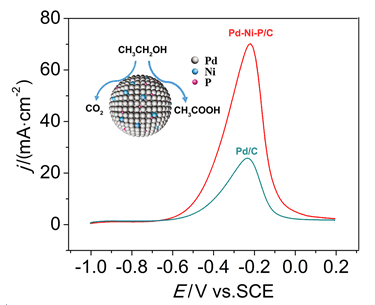摘要/Abstract

保证催化剂质量活性(通常以贵金属质量为计量)的基础上,减小催化剂中助催化剂的用量可有效降低燃料电池膜电极组(MEA)催化剂层的厚度,从而提高贵金属利用率和增大放电电压.于此,本文以微量NaH2PO2作为还原剂,适当调节合成溶液的碱度,成功制备了助催化剂Ni和P的掺杂量分别低至0.2%(w)和0.05%(w)的三元碳载Pd-Ni-P纳米合金催化剂.所得催化剂在0.5 mol/L CH3CH2OH+1 mol/L NaOH溶液中的循环伏安表征显示,质量活性最高可达到2466 mA•mg-1 Pd,是商业化Pd/C催化剂的2.7倍;同时,计时电流法测试表明,该催化剂的稳定性相对于商业化催化剂提升了2.8倍.这说明所得低掺杂型Pd-Ni-P催化剂达到了上述设计要求.本工作可能为燃料电池高效低成本阳极催化剂设计制备提供新的思路.
关键词: 低掺杂合金, 电催化剂, 乙醇电氧化, 碱性介质, 性能增强
Among currently reported anodic nano-alloy electrocatlysts for direct alkaline ethanol fuel cells (DAEFCs), the mass fraction (w) of co-catalysts is generally larger than 20%. This could increase the thickness of the catalyst layer in Membrane Electrode Assembly (MEA), which not only decreases the discharge voltage of fuel cells, also reduces the utilization of the noble metals such as Pt and Pd. To solve this problem, here we synthesized a series of Pd-Ni-P alloy electrocatalysts with ultra-low doping amount of Ni and P, using ca. 1.5 mg NaH2PO2 as reducing agent. To obtain different doping amount of Ni and P, the pH value of the synthetic solution was adjusted from 8 to 12 by 0.1 mol/L NaOH. Inductively Coupled Plasma-Atomic Emission Spectrometry (ICP-AES) results showed that the mass fraction of Ni and P were low to 0.2% and 0.05%, respectively, when the pH value of the synthetic solution is 10. Transmission Electron Microscopy (TEM) images showed that nanoparticles were distributed evenly on the carbon base, and their mean particle sizes increased from ca. 3.78 nm to ca. 5.4 nm with alkalinity of synthetic solutions increasing. Cyclic Voltammograms in 0.5 mol/L CH3CH2OH+1 mol/L NaOH solution revealed that the catalyst obtained under the pH 10 synthetic solution (hereafter denoted as Pd-Ni-P/C-pH10) gave a highest apparent current density of ca. 2466 mA•mg-1 Pd, nearly 2.7 times in respect of that of the commercial Pd/C catalyst (JM). Meanwhile, the durability of Pd-Ni-P/C-pH10 for ethanol oxidation was improved by ca. 2.8 times compared to commercial catalyst. Relative to pure Pd, the binding energy of Pd 3d5/2of as-prepared catalysts all positively shifted, suggesting an obvious electronic interaction between Pd, Ni and P component in as-prepared catalysts. This interaction could led to a shift of the d-band center of Pd component, which may play a pivotal and dominated role in improving the catalytic performance for the ethanol electrooxidation in alkaline media.
Key words: low-doping alloy, electrocatalysts, ethanol oxidation reaction, alkaline media, enhanced performance
PDF全文下载地址:
点我下载PDF
